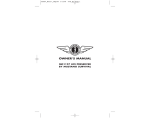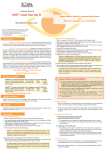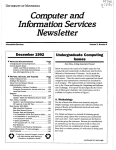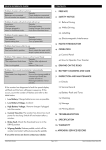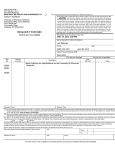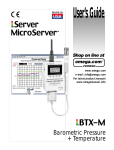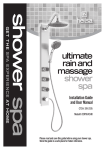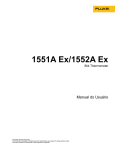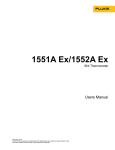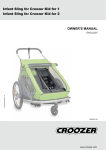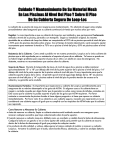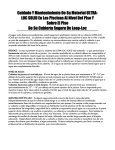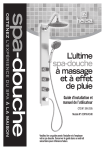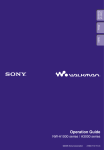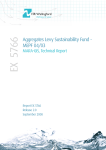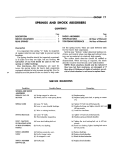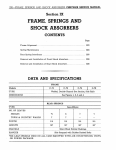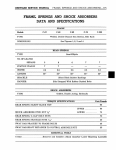Download Description and Maintenance Manual
Transcript
MUSTANG AVIATION COVERALL MAC-10 and MAC-11 DESCRIPTION AND MAINTENANCE MANUAL 28 April, 2005, Rev: 1.0 Mustang Survival Canada 3810 Jacombs Road Richmond, BC, V6V 1Y6 Tel: (604) 270-8631 Fax: (604) 270-0489 E-mail: [email protected] WEB: www.mustangsurvival.com Mustang Survival-USA 3870 Mustang Way Bellingham, WA USA 98226 Tel: (360) 676-1782 Fax: (360) 676-5014 E-mail: [email protected] Mustang Survival MAC-10 and MAC-11 Description and Maintenance Instructions 28 April, 2005, Rev: -- TABLE OF CONTENTS 1.0 INTRODUCTION .................................................................................................................1 1.1 1.2 1.3 1.4 GENERAL ..................................................................................................................................1 CONTACT ..................................................................................................................................1 RESPONSIBILITIES...................................................................................................................1 DESCRIPTION ...........................................................................................................................2 2.0 IMMERSION AND ANTI-EXPOSURE CLOTHING..............................................................3 2.1 2.2 2.3 HAZARDS ..................................................................................................................................3 DRY SUITS ................................................................................................................................3 WET SUITS ................................................................................................................................3 3.0 MAC-10 and MAC-11 FEATURES ......................................................................................4 3.1 3.2 3.3 3.4 3.5 3.6 3.7 3.8 3.9 3.10 3.11 3.12 3.13 3.14 GENERAL ..................................................................................................................................4 ACCESSORIES..........................................................................................................................4 HYPOTHERMIA PROTECTION.................................................................................................4 FLAME RESISTANCE................................................................................................................5 FLOTATION ...............................................................................................................................6 WEIGHT AND DIMENSIONS .....................................................................................................6 TUG-TITE® .................................................................................................................................6 ADJUSTABLE WAIST STRAPS.................................................................................................6 ADJUSTABLE ANKLE ZIPPER AND STRAPS..........................................................................7 STORAGE POCKETS................................................................................................................7 THERMAL HOOD ......................................................................................................................9 COMFORT ZIPPER .................................................................................................................10 DIFFERENCES BETWEEN THE MAC-10 and MAC-11..........................................................10 DONNING INSTRUCTIONS ILLUSTRATED ...........................................................................12 4.0 MAINTENANCE.................................................................................................................16 4.1 4.2 4.3 4.4 4.5 4.6 4.7 GENERAL ................................................................................................................................16 REGULAR CARE .....................................................................................................................16 CLEANING ...............................................................................................................................16 SERVICE..................................................................................................................................16 TREATMENT AFTER IMMERSION .........................................................................................17 INSPECTION............................................................................................................................17 REPAIRS..................................................................................................................................18 5.0 SUMMARY ........................................................................................................................21 6.0 PARTS LIST ......................................................................................................................22 i This document is for information purposes only. It is not a controlled document and may not be considered current when printed. Mustang Survival MAC-10 and MAC-11 Description and Maintenance Instructions 28 April, 2005, Rev: -- TABLE OF FIGURES Figure 1. Size Chart ..................................................................................................................................2 Figure 2. Insulation Graph ........................................................................................................................5 Figure 3. Adjustable Waist Straps.............................................................................................................6 Figure 4. Adjustable Ankle Zipper and Tug-Tite Straps ..........................................................................7 Figure 5. Survival Knife Pocket.................................................................................................................8 Figure 6. Hood Pocket ..............................................................................................................................8 Figure 7. Thermal Hood (Side and Front Views) ......................................................................................9 Figure 8. Comfort Zipper.........................................................................................................................10 Figure 9. MAC-10 and MAC-11 Aviation Coveralls.................................................................................10 Figure 10. MAC-11 Map Clip ..................................................................................................................11 Figure 11. Step a. (Donning Instructions) ...............................................................................................12 Figure 12. Step b. (Donning Instructions) ...............................................................................................12 Figure 13. Step c. (Donning Instructions) ...............................................................................................13 Figure 14. Step d. (Donning Instructions) ...............................................................................................13 Figure 15. Step e. (Donning Instructions) ...............................................................................................14 Figure 16. Step f. (Donning Instructions) ................................................................................................14 Figure 17. Step g. (Donning Instructions) ...............................................................................................15 Figure 18. Simulated Tears and Suggested Patch Configurations (Not to Scale) ..................................19 Figure 19. Mustang Survival Immersion Coverall Model MAC-10 and Index Numbers ..........................22 Figure 20. Parts List for the Mustang Survival Model MAC-10 and MAC-11 ..........................................23 Figure 21. Mustang Survival Immersion Coverall Model MAC11 and Index Numbers ...........................25 Figure 22. Parts List for the Mustang Survival Immersion Coverall Model MAC-11 Only.......................25 ii This document is for information purposes only. It is not a controlled document and may not be considered current when printed. Mustang Survival MAC-10 and MAC-11 Description and Maintenance Instructions 28 April, 2005, Rev: -- 1.0 INTRODUCTION 1.1 GENERAL 1.1.1 This manual provides information on the hazards of cold-water immersion; the function and features of the Mustang Aviation Coverall Model number MAC-10 and MAC-11. This manual also includes test, maintenance and repair instructions to assist qualified Aviation Life Support Equipment Technicians. 1.1.2 Read this manual thoroughly to become familiar with the operation of the zippers, Tug-Tite cinch straps and hood. The lives of aircrew may depend on the condition of the MAC-10 and MAC-11. Keep the manual in a convenient location for easy reference in the event that the suit requires inspection, repair or cleaning. 1.1.3 This manual consists of six sections, each section is organized into a number of subsections (see the Table of Contents). 1.2 CONTACT 1.2.1 For further information concerning this manual or the suit, contact: Government Technical Support Department Mustang Survival Corp. 3810 Jacombs Road Richmond, BC V6V 1Y6 Tel. (604) 270-8631 Fax (604) 270-0489 E-mail: [email protected] WEB: www.mustangsurvival.com 1.2.2 ‘Velcro’ is a registered trademark of American Velcro Inc. ‘Barreloc’, ‘Looploc’, and ‘Ladderloc’ are trademarks of ITW Plastiglide. ®’ ‘Tug-Tite is a registered trademark of Mustang Survival Corp. ‘Nomex ’ is a registered trademark of DuPont. 1.3 RESPONSIBILITIES 1.3.1 Each operational organization is responsible for the instruction and survival training of all aircrew and aircraft passengers in the following: a. Operation of the suit b. Purpose, use and operation of all accessories c. Importance and method of inspections 1.3.2 The Aviation Life Support Equipment shop is responsible for: a. Inspection upon first issue from the supply depot or contractor 1 This document is for information purposes only. It is not a controlled document and may not be considered current when printed. Mustang Survival MAC-10 and MAC-11 Description and Maintenance Instructions 28 April, 2005, Rev: -- b. Periodic inspection and testing of the suit (section 4.6) c. Maintenance, cleaning and repair when required d. Requisitioning and maintaining stocks of spare parts e. Maintenance of inspection records for all MAC-10 and MAC-11 units 1.4 DESCRIPTION 1.4.1 Purpose 1.4.1.1 The MAC-10 (and MAC-11) is a blend of ergonomic design and emergency hazards protection. The suit is specifically engineered for constant-wear environment exposure protection for aircrew passengers flying over water in light aircraft, float planes, helicopters, long range patrol aircraft and in some cases high performance jets. 1.4.2 Sizes 1.4.2.1 Seventeen sizes are available. User measurements should be taken over the intended underclothing. Figure 1. Size Chart Size 1 2 3 4 5 6 7 8 9 9a 10 11 12 12a 13 14 15 Height Cm 155-160 160-165 165-170 160-165 165-170 170-175 165-170 170-175 175-180 180-185 170-175 175-180 180-185 185-190 175-180 180-185 185-190 Inches 61-63 63-65 65-67 63-65 65-67 67-69 65-67 67-69 69-71 71-73 67-69 69-71 71-73 73-75 69-71 71-73 73-75 2 Chest Size Cm Inches 76-84 30–33 76-84 30–33 76-84 30–33 84-91 33-36 84-91 33-36 84-91 33-36 91-99 36-39 91-99 36-39 91-99 36-39 91-99 36-39 99-107 39-42 99-107 39-42 99-107 39-42 99-107 39-42 107-114 42-45 107-114 42-45 107-114 42-45 This document is for information purposes only. It is not a controlled document and may not be considered current when printed. Mustang Survival MAC-10 and MAC-11 Description and Maintenance Instructions 28 April, 2005, Rev: -- 2.0 IMMERSION AND ANTI-EXPOSURE CLOTHING 2.1 HAZARDS 2.1.1 Cold-water immersion is a life-threatening situation, and your survival depends on the clothing you wear. Cold, hypothermia, shock, loss of dexterity and mental sharpness and drowning are your primary concerns. Many strong swimmers drown within metres of safety in cold water. This suggests that many drown as a result of the rapid shock of immersion, causing immediate hyperventilation, water ingestion, and often heart failure, which may occur in water below º 15 C. 2.1.2 Without adequate buoyancy and insulation, individuals rely on swimming ability and endurance for survival. Your strength and endurance is seriously diminished in colder water, reducing your ability to overcome waves, currents, spray, etc. 2.1.3 Hypothermia results when your body loses heat faster than it can be replaced. This can occur º in any environment below 37 C, our normal body core temperature. Water conducts heat away from our body 25-30 times faster than air, presenting a high risk. 2.1.4 Shivering is the body’s way of generating heat to replace the heat that is lost. The smallest blood vessels constrict close to the skin, reducing the blood circulation to your hands and feet. Circulation to the body core is restricted, where it is needed most, resulting in a loss of dexterity. As the effect of cold increases, muscles weaken and stiffen, leading to the loss of feeling and reduced co-ordination. Your decision-making and thinking processes slow down. 2.1.5 Proper clothing reduces many of these hazards, improving your chances of survival. Clothing should provide insulation from the cold and should not hinder mobility. Buoyancy should be provided, either inherently in your outfit, or with an additional life preserver, preferably both. 2.1.6 Generally there are two types of immersion protective clothing: a. Dry suits b. Wet suits 2.2 DRY SUITS 2.2.1 Dry suits protect you during cold-water immersion by using the trapped air as an insulation layer from the cold water. Most dry suits utilise seals at the wrists, neck and ankles, unless incorporating gloves and boots. These seals are made from waterproof materials, insulated or non-insulated. 2.3 WET SUITS 2.3.1 Wet suits allow some water in, but restrict water movement into and out of the suit. Your body heats up the water that becomes, more or less, trapped in the suit. If the openings of the suit become restricted, the warmed water will stay inside the suit longer, so heat loss is reduced. If a wet suit is damaged or torn, the level of protection is reduced, although typically less than with dry suits. 2.3.2 The typically more comfortable wet suits are more appropriate for constant wear than are dry suits. 3 This document is for information purposes only. It is not a controlled document and may not be considered current when printed. Mustang Survival MAC-10 and MAC-11 Description and Maintenance Instructions 28 April, 2005, Rev: -- 3.0 MAC-10 AND MAC-11 FEATURES 3.1 GENERAL 3.1.1 This section identifies and locates the features of the MAC-10 (and MAC-11) wet suits. The two suits shared and unique features are detailed. Familiarize yourself with all the features of the suits to maximize its effectiveness. 3.1.2 The MAC-10 has zippered ankle gussets that assist in donning and doffing. A range of pockets is provided for the storage of personal items, notepads, pens and survival equipment, including a survival knife. An insulated thermal protective hood, stored in the right leg pocket, minimizes heat loss and provides good fire protection for the head. 3.1.3 The MAC-10 is compatible with any lifejacket, such as Mustang’s twin-chambered FAA approved constant wear inflatable lifejacket (model MD1127). 3.1.4 The MAC-10 is constructed of two layers of Nomex . The fire retardant closed-cell foam interlining provides buoyancy and thermal insulating performance that protects against hypothermia. The suit very effectively protects the user in the event of cold-water immersion. 3.1.5 The waist adjustment and Tug-Tite closure systems at the wrists and ankles provide an effective means of closure for minimizing cold water flushing upon immersion. It also provides a means for ventilation during operation to minimize heat stress. 3.1.6 A thermal protective hood is provided in the right lower pant leg pocket for emergency coldwater deployment. A variety of closable storage pockets are provided on the left shoulder, chest, thigh and lower legs. The right thigh pocket is designed specifically for the provision and deployment of a survival knife. 3.1.7 The knee and seat areas are reinforced with durable leather anti-abrasion patches. 3.1.8 The MAC-11’s outer shell is orange Nomex , for increased visibility during SAR activities. 3.2 ACCESSORIES 3.2.1 Thermal Gloves (Model MA7102) Insulated, thermal protective gloves are optionally available. The lower left leg pocket is provided for storage of this glove. 3.2.2 Carry Case (Model MA7105) A durable water resistant nylon carry case is optionally available for storage and handling of the coverall. The case is equipped with a zippered closure and sturdy handles. 3.3 HYPOTHERMIA PROTECTION 3.3.1 Immersion in cold water is a danger for anyone working on or near the water. The length of time a person can survive in cold water largely depends on both the water’s temperature and the thermal protection of the victim’s protective clothing. 3.3.2 To create the most effective protection against hypothermia, Mustang Survival begins by evaluating the clothing’s immersed Clo value, which depicts the level of thermal insulation a garment provides. Simply speaking, we determine the rate at which heat is lost from the body, as well as the difference in temperature between the skin and the water. Predictions can be made, from the Immersed Clo values, of the rate at which a person’s body temperature will drop in cold water. ‘Clo’ is a measurement of insulation, much like the ‘R’ values assigned to ® ® 4 This document is for information purposes only. It is not a controlled document and may not be considered current when printed. Mustang Survival MAC-10 and MAC-11 Description and Maintenance Instructions 28 April, 2005, Rev: -- º fibreglass house insulation. It is difficult to survive longer than one hour in 5 C water with just standard clothing. 3.3.3 Figure 2 indicates random samples of Immersed Clo values and the corresponding estimation º º of survival time in cold water (assuming a thin person with a 5.5 F (3 C) drop in body core temperature. 3.3.4 The Mustang models MAC-10, extended-wear wet suits have been rated at 0.47 immersed clo (calm water). This value was achieved when tested on a thermally instrumented manikin with Tug-Tite closures secured, and thermal protective hood donned. Figure 2. Insulation Graph Estimated Calm Water Survival Time (hours) º º Water Temperature ( C and F) NOTE: When using Figure 2, keep in mind that the chart was derived empirically by mathematical modeling and conservatively applied to the tenth percentile (thin) individual. With the complexity of factors involved, there is no guarantee as to the accuracy of the predicted survival time on an individual case basis. 3.4 FLAME RESISTANCE 3.4.1 A three-layer aramid/PVC/aramid construction provides outstanding protection from radiant heat and fire. The MAC-10 coverall achieves a Thermal Protective Performance (TPP) rating 5 This document is for information purposes only. It is not a controlled document and may not be considered current when printed. Mustang Survival MAC-10 and MAC-11 Description and Maintenance Instructions 28 April, 2005, Rev: -- of 1,900 kJ/m2. This equates to twenty seconds protection from second-degree burn, under exposure to a heat flux of 84-kW/ m2. 3.4.2 A heat flux of 84-kW/ m2 corresponds to conditions around a crashed aircraft when fuel is burning fiercely. Full manikin burn tests conducted on the MAC-10 demonstrate that no second or third-degree burns were allowed within its area of coverage. This contrasts with second-degree burns to 57% of the body surface area covered by a typical plain Nomex flight suit. 3.5 FLOTATION 3.5.1 The MAC-10 and MAC-11 provide an inherent buoyancy of 18-21 lbs. depending on its size. This is well below the 35 lbs. maximum recommended for ditched helicopter egress. 3.6 WEIGHT AND DIMENSIONS 3.6.1 A lightweight suit, at approximately 1.8 kg (4 lbs.), for size Large. 3.7 TUG-TITE 3.7.1 Tug-Tite is another of Mustang’s personal safety features. It is a 360 adjustable, tight-seal closure system at wrists and ankles that mechanically reduces the entry of cold air and water during foul weather and minimizes water exchange during immersion. It incorporates a registered two-part pulley mechanism that permits rapid closing with a simple one-handed pulling action and it requires no tucks or gathers of the material. 3.8 ADJUSTABLE WAIST STRAPS 3.8.1 The waist straps (see Figure 3) are constructed of one-inch wide nylon webbing and provide adjustment after donning the suit. The straps also assist donning in non-emergency situations. If the straps are cinched right after pulling the suit up to the waist, then it will tend to stay up while you put on the sleeves and pull the neck seal over your head. The straps also assist in gathering up excess material. ® ® º Figure 3. Adjustable Waist Straps T-tab Velcro 3.8.2 Make adjustments by pulling on the T-tabs at the free ends of the straps. The loose end should be secured with the Velcro on the opposite side of the waist (see figure 3). 6 This document is for information purposes only. It is not a controlled document and may not be considered current when printed. Mustang Survival MAC-10 and MAC-11 Description and Maintenance Instructions 28 April, 2005, Rev: -- 3.9 ADJUSTABLE ANKLE ZIPPER AND STRAPS 3.9.1 A zipper is provided, at the bottom of each leg (see figure 4), for a closer fit. The Tug-Tite ankle adjustment straps are constructed of one-inch wide nylon webbing. They gather excess material, providing improved mobility while boarding rafts, etc. Figure 4. Adjustable Ankle Zipper and Tug-Tite Straps Tug-Tite Ankle Adjustment Ankle Zipper 3.10 STORAGE POCKETS 3.10.1 The pockets located on the legs are constructed of Nomex (optional) when not in use. 7 and store the hood and mitts This document is for information purposes only. It is not a controlled document and may not be considered current when printed. Mustang Survival MAC-10 and MAC-11 Description and Maintenance Instructions 28 April, 2005, Rev: -- 3.10.2 Peeling down the Velcro edges easily accesses the Survival Knife pocket on the right thigh (see Figure 5). Figure 5. Survival Knife Pocket Velcro Knife Holder 3.10.3 The pocket for the hood is located on the lower right leg and opens upward from the top of the pocket. Ensure that the hood is attached to the suit using the lanyard when it is not being worn. Figure 6. Hood Pocket Neoprene Hood Lanyard Velcro 8 This document is for information purposes only. It is not a controlled document and may not be considered current when printed. Mustang Survival MAC-10 and MAC-11 Description and Maintenance Instructions 28 April, 2005, Rev: -- 3.11 THERMAL HOOD 3.11.1 A great deal of body heat escapes from the head area. Insulating the head in immersion situations greatly enhances a person’s opportunity to survive. Remove the hood from the right lower leg pocket and donning when needed. Figure 7. Thermal Hood (Side and Front Views) 3.11.2 The thermal hood (see figure 7) is constructed of 3 mm neoprene, laminated with stretch nylon on the inside. The stretch nylon provides resistance to tears, allowing the hood to be donned easily. The hood is red for increased visibility and is connected to the pocket with a lanyard, to avoid loss in high seas or adverse conditions. To avoid snagging during aircraft egress, disconnect the lanyard from the hood and store it the pocket. 3.11.3 An adjustment strap is provided on the collar to allow securing, where necessary. The hood is universally sized and can be adjusted to fit by pulling on the free end of the collar’s adjustment strap, until a comfortably snug fit is achieved. NOTE: Wear the hood over the chin, while maintaining a breathing passage, for maximum coverage and protection. 9 This document is for information purposes only. It is not a controlled document and may not be considered current when printed. Mustang Survival MAC-10 and MAC-11 Description and Maintenance Instructions 28 April, 2005, Rev: -- 3.12 COMFORT ZIPPER 3.12.1 The comfort zipper is available for convenient relief; simply lift the lower slider pull. Figure 8. Comfort Zipper Comfort Zipper Slider Pull 3.13 DIFFERENCES BETWEEN THE MAC-10 AND MAC-11 3.13.1 While very similar, the MAC-10 and MAC-11 Aviation Coveralls are different (see figure 9). Some of the differences, such as the colour, are obvious; the MAC-10 is usually sage green (also available in orange and royal blue) and the MAC-11 is orange. Alternative colours may be used based on availability. Other changes are listed below. Figure 9. MAC-10 and MAC-11 Aviation Coveralls 10 This document is for information purposes only. It is not a controlled document and may not be considered current when printed. Mustang Survival MAC-10 and MAC-11 Description and Maintenance Instructions 28 April, 2005, Rev: -- 3.13.2 The MAC-10 has a zippered thigh and Velcro closure calf pocket. And instead of a thigh pocket, the MAC-11 is fitted with a map clip in the same location, just above the knee patch. 3.13.3 The MAC-10 has leather reinforcement on the seat and knees, while the MAC-11 only uses leather on the knees. 3.13.4 The MAC-10 has the winged Mustang logo screened on the shoulder and the MAC-11 does not. Figure 10. MAC-11 Map Clip Map Clip 3.13.5 The MAC-11 employs reflective SOLAS tape on the shoulders and hood and the MAC-10 does not (see Figure 9). 11 This document is for information purposes only. It is not a controlled document and may not be considered current when printed. Mustang Survival MAC-10 and MAC-11 Description and Maintenance Instructions 28 April, 2005, Rev: -- 3.14 DONNING INSTRUCTIONS ILLUSTRATED a. Climb into the suit, and pull it up to your waist. Figure 11. Step a. (Donning Instructions) b. Insert your arms into the sleeves, Velcro the opening closed and pull the zipper up. Figure 12. Step b. (Donning Instructions) 12 This document is for information purposes only. It is not a controlled document and may not be considered current when printed. Mustang Survival MAC-10 and MAC-11 Description and Maintenance Instructions 28 April, 2005, Rev: -- c. Pull the vertical ankle zipper down, securely closing the zipper. Figure 13. Step c. (Donning Instructions) d. Separate the ankle T-tab and pull the strap in one fluid motion, taking care to keep the strap straight and untwisted, until the wrist or ankle seal is as tight as can comfortably be tolerated. Figure 14. Step d. (Donning Instructions) Velcro T-tab 13 This document is for information purposes only. It is not a controlled document and may not be considered current when printed. Mustang Survival MAC-10 and MAC-11 Description and Maintenance Instructions 28 April, 2005, Rev: -- e. When cinched, fasten the ankle T-tab around the wrist or ankle. To release the seal, undo the T-tab, unwind the strap then pull firmly on the release tab. Figure 15. Step e. (Donning Instructions) f. Separate the wrist T-tab and pull the strap in one fluid motion, taking care to keep the strap straight and untwisted, until the wrist or ankle seal is as tight as can comfortably be tolerated. Figure 16. Step f. (Donning Instructions) T-tab Velcro 14 This document is for information purposes only. It is not a controlled document and may not be considered current when printed. Mustang Survival MAC-10 and MAC-11 Description and Maintenance Instructions 28 April, 2005, Rev: -- g. When cinched, fasten the wrist T-tab around the wrist. To release the seal, undo the Ttab, unwind the strap then pull firmly on the release tab. Figure 17. Step g. (Donning Instructions) 15 This document is for information purposes only. It is not a controlled document and may not be considered current when printed. Mustang Survival MAC-10 and MAC-11 Description and Maintenance Instructions 28 April, 2005, Rev: -- 4.0 MAINTENANCE 4.1 GENERAL 4.1.1 Regular care and inspection of the aviation coveralls will help ensure that the system performs as designed in both working and emergency survival situations. Proper care of this garment is extremely important for best results and extended service. Failure to follow the procedures outlined in this document for usage, maintenance, repair and general care may void any warranties for this product. 4.2 REGULAR CARE 4.2.1 The suit should be hand washed in warm water (100 F) using mild soap only. Rinse thoroughly in clean tepid water and hang freely on a sturdy non-metal hanger to air dry. º CAUTION: The suit should never be placed in an electric or gas dryer. This causes irreparable damage to the buoyant interliner. Do not stow the suit when damp or wet. Do not use bleach, solvents or any chlorine products. Do not iron. After immersion in salt water, rinse the suit thoroughly in clean tepid water and hang freely to air dry. Heavy soiling can be removed using a soft brush. See section 4.3. 4.3 CLEANING 4.3.1 Mud and soil stains should be removed from the suit. Allow the mud to dry and brush off with a soft bristle brush. Alternatively, rinse the suit with fresh warm water and remove the soil with a sponge or a soft brush and mild detergent. After cleaning, the suit should be thoroughly airdried. 4.3.2 Slight oil stains can be removed by gently scrubbing in tepid water with a soft brush and household detergent. After cleaning, the suit must be thoroughly air-dried. NOTE: DO NOT DRY CLEAN. Solvent used in the dry cleaning process causes serious deterioration to the PVC foam buoyant interliner. 4.4 SERVICE 4.4.1 Storage 4.4.1.1 The MAC10 and MAC11 Aviation Coveralls should be stored in: a. A cool dry area, where an even temperature may be maintained. b. An area without excessive sunlight, ozone, and ultra violet rays, and is free of petroleum products (POL), acids and other damaging contaminants. WARNING: Never store the suit wet. 16 This document is for information purposes only. It is not a controlled document and may not be considered current when printed. Mustang Survival MAC-10 and MAC-11 Description and Maintenance Instructions 28 April, 2005, Rev: -- 4.5 TREATMENT AFTER IMMERSION 4.5.1 Fresh Water Immersion 4.5.1.1 If the suit is stained or dirty, rinse well in tepid water. Stained or heavily soiled areas may be gently scrubbed with a soft brush and household soap. Rinse well in clean fresh water until all dirt and soap are removed. Allow the suit to dry naturally, preferably by hanging the suit in the open air. 4.5.2 Salt Water and Chlorinated Immersion 4.5.2.1 Soak the suit in fresh water for 30 minutes. Rinse as often as necessary with clean fresh water until all dirt, salt and chlorine is removed. Allow the suit to dry naturally, preferably by hanging the suit in the open air. 4.5.3 Service Life 4.5.3.1 The suit’s service life is determined on condition rather than age. Suits may remain in service if properly maintained and they pass all tests and inspections. 4.6 INSPECTION 4.6.1 Inspection Intervals 4.6.1.1 Personnel who are familiar with this type of survival equipment should conduct complete coverall inspection on a regular basis. All materials and components should be visually inspected for abrasion, material damage or missing components, and extensive soiling or stains. 4.6.1.2 The MAC-10 (and MAC-11) suit should be periodically inspected (section 4.6.3): a. Every 180-240 days, depending on the environmental conditions of usage. The 180-day inspection cycle is recommended for hotter, drier environments and the 240-day cycle is for moderate climates. b. Whenever the integrity of the suit is in doubt. 4.6.2 Visual and Pre-flight Inspection 4.6.2.1 A close visual inspection should be performed prior to issue by the issuer and the individual, to whom the suit is issued. 4.6.2.2 To perform a close visual inspection, ensure: a. Fabric and construction seams have no burns, tears, separations or holes; or contamination by gas, oil, grease or acid. b. That all seams on the outer shell are intact and that no foam is visible either inside or outside the suit due to rips in the covering material. c. All metal components are intact and free from damage and corrosion. d. All slide fasteners are intact and are operating freely and smoothly. e. That the coverall system has no missing or damaged components. Major components include various storage pockets and thermal protective hood. Refer to section 6.0 for the location of major components. 17 This document is for information purposes only. It is not a controlled document and may not be considered current when printed. Mustang Survival MAC-10 and MAC-11 Description and Maintenance Instructions 28 April, 2005, Rev: -- f. Adjustment and closure systems are operating freely and securing properly. 4.6.3 Periodic Inspection 4.6.4 A suitably trained life support technician should carry out the in-depth periodic inspection. This inspection includes all the points listed in the close visual inspection (section 4.6.2.2). In addition, the suit’s foam should be checked for separating and thinning, especially in the buttocks area. 4.7 REPAIRS 4.7.1 General 4.7.1.1 The performance of this coverall system as an effective working garment and survival aid is dependent on the condition of the suit. Qualified personnel at a suitable service and repair site should perform any repairs. It is extremely important that damaged suits are handled in accordance with the following user repair requirements. These instructions provide critical information only in regards to the correct materials and procedures for suit repair by the user. 4.7.1.2 Qualified repair personnel can normally perform minor repairs, with adequate facilities. The manufacturer should do all major repairs. This section provides some information to assist with minor or emergency repairs to the suit and related components. 4.7.2 Limits of Repair 4.7.2.1 Small rips, tears or separations of seams, pockets, anti-abrasion patches or attachments can often be effectively repaired using suitable materials and equipment. More extensive damage, such as very large rips, tears; the original manufacturer should repair holes or abrasions. WARNING: Full suit or component replacement is necessary where damage is extensive enough that simple repair to the suit or component will not restore the item to perform as originally intended. 4.7.3 Repair Materials 4.7.3.1 The full description and part numbers of the materials required for repairs are detailed in section 6.0 of this manual. 4.7.4 Seam Repair ® 4.7.4.1 Stitching can repair separated or torn seams. All stitching must be done with a Nomex thread. Stitching must not pass through the buoyant interliner, if the interliner is not already presently attached at that location. 4.7.5 Fabric Repair 4.7.5.1 Stitching can often repair small rips or tears in fabric, which are not overly frayed or abraded. Where patches of material are used to repair small rips, tears or holes, the material must be ® Nomex of the same weight. Refer to section 6.0 for a list of materials and components utilized in this system. Patches must be fully stitched so as not to leave any free open edges that are capable of being snagged. 4.7.6 Stitching 4.7.6.1 All stitching should be done with nylon thread and be a single needle lockstitch, conforming to type 301 of CAN/CGSB 54-GP-1. Stitching density should be eight to ten stitches per inch and 18 This document is for information purposes only. It is not a controlled document and may not be considered current when printed. Mustang Survival MAC-10 and MAC-11 Description and Maintenance Instructions 28 April, 2005, Rev: -- all broken threads, seam ends and ends of stitching should be backstitched not less than 0.5 ® inch. Surge stitch the edges of the Nomex material to avoid fraying. ® 4.7.6.2 The Nomex thread should meet the requirements of federal Standard V-T-295, Type II, Class 1, and Size E, preferably matching the colour of the material being sewn. Most of the seam allowances are 0.5 inch. 4.7.6.3 Stitching should not catch up so much material that the resultant “fit” of the suit is affected, and should extend a minimum of one half inch beyond ends of rips or tears. WARNING: Do not stitch through any neoprene. Hood seams have been glued and taped, and any perforation of the neoprene with stitching will result in leakage. 4.7.7 Patching 4.7.7.1 All patching of minor tears and holes should be carried out as follows: a. The repair patches, to be made from the original material (see figure 18), must extend by not less than one inch beyond the perimeter of the damage; i.e. if the diameter of the jagged hole is one inch, the patch should be three inches in diameter. If a straight tear is 1.5 inches long, the patch should be 3.5 inches by two inches. L-shaped tears should be treated as round holes, reckoning the distance between the ends of the tear as the “diameter”. Figure 18. Simulated Tears and Suggested Patch Configurations (Not to Scale) Jagged Tear Patch Straight Tear Patch L-Shaped Tear Patch b. Patches should be circular or rectangular, with rounded corners. c. Repair closely grouped small holes or tears with one large patch, rather than several small ones. Patches must NOT overlap one another. 19 This document is for information purposes only. It is not a controlled document and may not be considered current when printed. Mustang Survival MAC-10 and MAC-11 Description and Maintenance Instructions 28 April, 2005, Rev: -- d. Stitch all patches to the outside of the suit. The colour of the patch should preferably be a close match to the suit colour. e. Firmly roll (with a suitable roller) glued areas to remove all entrapped air, channels and wrinkles achieving an adequate bond. 4.7.8 Buoyant Interliner Repair 4.7.8.1 The buoyant interliner consists of a fully integrated fire retardant closed-cell PVC foam. The interliner is an assembly of inserts cemented together to form a wet suit arrangement. The interliner is stitched into the coveralls at the openings of the wrists, ankles, and neck and along the slide fastener openings only. 4.7.8.2 Damage to the foam material is seriously detrimental to both buoyancy and hypothermia protection characteristics. Accordingly, the original manufacturer should do any repairs to the interliner. Other repairs must be done with extreme care, particularly: a. Do not stitch through the foam. Penetration of the foam reduces available buoyancy, and increases the potential for exposure to the elements. b. Do not remove or replace any foam material. c. Do not fold, crease or otherwise alter the foam material in any way. 4.7.9 Gluing 4.7.9.1 Gluing can effectively repair small rips or tears in the hood. Gluing should only be performed in a clean, dry, well-ventilated area. Repair personnel should wear protective rubber gloves and follow the adhesive supplier’s guidelines for use and preparation. All neoprene foam surfaces must be clean and dry prior to gluing. Mustang PN GL1001 (Bostick 1125A) is recommended for repairs. 4.7.9.2 To glue a section of the hood’s foam: a. Apply a coat of the adhesive over the full contact area using a small brush and allow drying until tacky. b. Apply a second coat of the adhesive over the full contact area and allow drying until tacky. c. Join the surfaces carefully by pressing together with the gloved fingers of both hands. d. Allow the repair area to dry for a minimum of 24 hours prior to wearing or reissuing the suit. 20 This document is for information purposes only. It is not a controlled document and may not be considered current when printed. Mustang Survival MAC-10 and MAC-11 Description and Maintenance Instructions 28 April, 2005, Rev: -- 5.0 SUMMARY 5.1 The Mustang Survival Immersion Coverall Model MAC-10 and MAC-11 are extended wear wet suits that protect aircrew in harsh marine environments with cold-water immersion features and inherent buoyancy. The flame resistant suit is easily donned and maintained. Qualified technicians, with proper equipment, or Mustang Survival Corp may make suit repairs. A well maintained MAC-10 or MAC-11 means survival in emergency situations for which normal clothes were not designed. 21 This document is for information purposes only. It is not a controlled document and may not be considered current when printed. Mustang Survival MAC-10 and MAC-11 Description and Maintenance Instructions 28 April, 2005, Rev: -- 6.0 PARTS LIST 6.1 This section identifies the materials used in the construction of the Mustang Constant Wear Aviation Coverall Model MAC-10 (and MAC-11). These materials are highly recommended for repairs and replacements. Item order quantity is based on their availability. Figure 19. Mustang Survival Immersion Coverall Model MAC-10 and Index Numbers 16 1 15 2 14 3 13 4 12 5 6 7 11 8 10 9 *Knee patch colour is actually sage 22 This document is for information purposes only. It is not a controlled document and may not be considered current when printed. Mustang Survival MAC-10 and MAC-11 Description and Maintenance Instructions 28 April, 2005, Rev: -- Figure 20. Parts List for the Mustang Survival Model MAC-10 and MAC-11 INDEX NUMBER PART NUMBER NOMENCLATURE MIN ORDER QUANTITY 1 VARIES Contact Mustang Survival for the correct entry zipper. 2 VE93207 50 MM #613 SWAMP LOOP FASTENER (FIRE RETARDENT) 3 ZI950013 6 IN. NOMEX TAPE (ZIPPER) 4 TA102713 1 IN. GROS GRAIN RIBBON TAPE, BLACK 1 ROLL (100 yd) 5 VE91827 25 MM #613 SWAMP HOOK FASTENER (FIRE RETARDENT) 50 m (54.68 yd) 6 HD7460 WELDED STAINLESS STEEL LOOP 7 VE91837 25 MM #613 SWAMP LOOP FASTENER (FIRE RETARDENT) 8 FA102927 SAGE GREEN GLOVE SPLIT (LEATHER) ® 10 EA 50 m (54.68 yd) 10 EA (MAC-10 ONLY) 20 EA 50 m (54.68 yd) 1 SKIN (10 SQ ft) (15.24 SQ m) ® 10 EA 9 ZI950113 9.5 IN. NOMEX TAPE (ZIPPER) 10 FD2303 3.5 MM NEOPRENE F.R. LAMINATED 2-SIDE 1 SHEET (1.27 m x 2.25 m) (1.48 yd x 2.5 yd) 1 ROLL (400 m) (437.45 yd) 11 LC10237 OLIVE GREEN FILLER CORD LACE ON ROLLS, SPUN POLYESTER 12 HD721630 EYELET MILLED BLACK OXY SNAP 50 EA 13 HD721530 STUD, BLACK OXY SNAP 50 EA 14 HD721430 SOCKET, BLACK OXY SNAP 50 EA 15 HD721330 26 LIGNE MUSTANG SURVIVAL BLACK OXY CAP 16 FA112527 60 IN. CALENDARED NOMEX 6 OZ. OMNIWEAVE SAGE GREEN (MAC-10 ONLY) 50 EA 10 EA 17 EL100010 1 IN. Q43 WHITE ELASTIC 18 EL100210 0.5 IN. WHITE ELASTIC PT. NO. 12 19 FA11305 60 IN NOMEX , NAVY, PLAIN WEAVE (LINING) 20 MA7102 NEOPRENE GLOVE UNIVERSAL SIZE (OPTIONAL) 21 FD300110 1/8 IN. X 56 IN. X 360 IN. AIRSOFT FOAM 22 TA104813 1 5/8 IN. BLACK LYCRA SLIT STRAIGHT CUT (HOOD) 23 TH885010 ANEFIL TEX-30, WHITE ® 1 ROLL (50 m) ® 1 ROLL (144 yd) 1 m (11 ft) 1 EA 1 SHEET 1 ROLL (50 m) (54.68 yd) 1 CONE 23 This document is for information purposes only. It is not a controlled document and may not be considered current when printed. Mustang Survival MAC-10 and MAC-11 Description and Maintenance Instructions 28 April, 2005, Rev: -- INDEX NUMBER PART NUMBER NOMENCLATURE MIN ORDER QUANTITY 24 TH886013 BLACK BONDED NOMEX THREAD 1 CONE 25 TH88514 CSB 46 NY51 RED (MAC-10 ONLY) 1 CONE ® ® 26 TH886027 SAGE GREEN BONDED NOMEX THREAD (MAC-10 ONLY) 27 GL1001 BOSTIK 1125A ADHESIVE GLUE 1 CONE 1 CAN (20 L) (5.28 galls US) 24 This document is for information purposes only. It is not a controlled document and may not be considered current when printed. Mustang Survival MAC-10 and MAC-11 Description and Maintenance Instructions 28 April, 2005, Rev: -- Figure 21. Mustang Survival Immersion Coverall Model MAC11 and Index Numbers 1 5 2 4 3 Figure 22. Parts List for the Mustang Survival Immersion Coverall Model MAC-11 Only INDEX NUMBER PART NUMBER NOMENCLATURE MIN ORDER QUANTITY 1 TA1018 2 IN. SOLAS REFLECTIVE TAPE 1 ROLL (50 yd) (45.72 m) 20 EA 2 HD772613 PLASTIC MAP CLIP 3 FA10292 COWHIDE SPLIT, TEXAS ORANGE 1 skin (10 SQ ft) (15.24 SQ m) 4 FA11252 60 IN. CALENDARED NOMEX OMNIWEAVE, ORANGE 5 TA1019 2 IN. SOLAS SELF-ADHESIVE REFLECTIVE TAPE 1 m (1.09 yd) 1 ROLL (50 yd) (45.72 m) 6 TH88602 BONDED NOMEX THREAD, ORANGE 25 1 CONE This document is for information purposes only. It is not a controlled document and may not be considered current when printed.




























